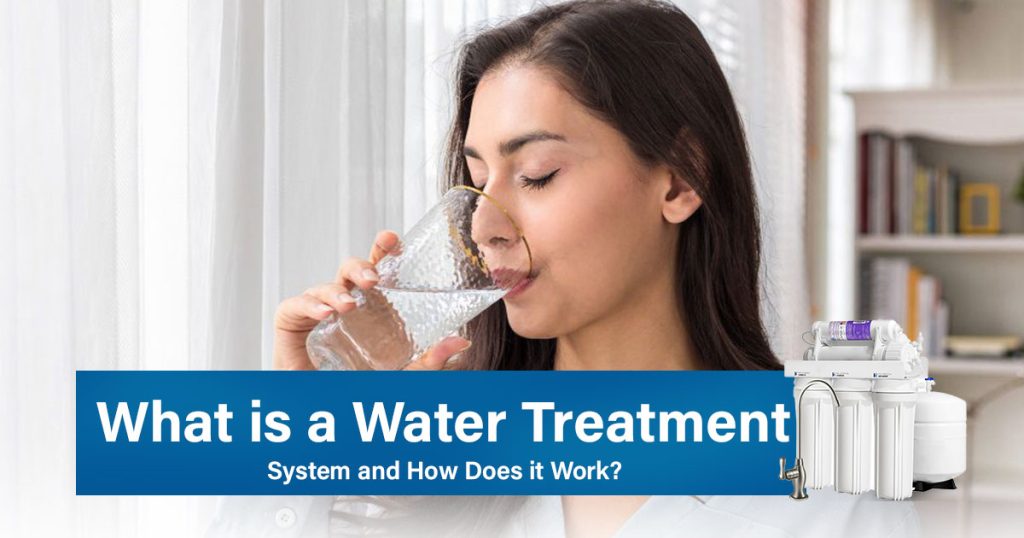A water treatment system is a structured process that removes contaminants from water and makes it safe to drink. Water treatment systems are crucial for homes and industries because untreated water holds harmful elements. They clear out dirt, sand, rust, bacteria, viruses, pesticides, chlorine, heavy metals like lead and mercury, and chemical byproducts.
In the United States, more than 286 million people rely on community water systems that use treatment steps to keep water safe. The process includes several stages. Water flows through filters that trap particles. Activated carbon reduces chlorine, bad taste, and odor. Special membranes in reverse osmosis units stop tiny contaminants, including dissolved salts, nitrates, and microbes.
Ultraviolet light kills bacteria and viruses. In industry, treatment protects equipment from scale and corrosion while also meeting safety standards. Membranes play a central role because they block substances as small as 0.0001 microns, which means they remove chemicals, salts, and microorganisms that slip through basic filters. This makes treated water clean, clear, and safe for daily use in drinking, cooking, and production.
What is a Water Treatment System?
A water treatment system is a process that removes harmful substances from water to make it safe for drinking and industrial use. Its main purpose is to supply clean water that protects health and supports daily activities. In homes, treatment systems reduce dirt, chlorine, bacteria, pesticides, and heavy metals such as lead and mercury.
In industries, they provide purified water for food processing, medicine, and manufacturing, where water quality affects product safety and equipment life. According to the U.S. Environmental Protection Agency, more than 90% of Americans get treated water through regulated systems. These systems make sure water meets strict standards before reaching households and factories.
What are the Step-by-Step Processes of Modern Water Treatment Systems?
The step-by-step process of a modern water treatment system includes several technical stages that remove impurities and deliver safe water for homes and industries. Each step improves water quality by reducing contaminants, protecting health, and enhancing taste and clarity.
The step-by-step process of a modern water treatment system includes:
1- Screening
The process of screening eliminates big items, including leaves, plastic, and debris. This action helps in avoiding damage to equipment and will make the subsequent processes run without any problem. Clean entry water supports better filtration and lowers system strain.
2- Coagulation and Flocculation
In this step, chemicals such as aluminum sulfate are added to bind small particles. The particles form larger clusters called flocs. This makes dirt, clay, and organic matter easier to remove in later stages.
3- Sedimentation
The water rests in tanks, and the heavy flocs settle to the bottom. This process clears the water of suspended solids. It reduces turbidity and prepares water for finer filtration.
4- Filtration
Water passes through layers of sand, gravel, and activated carbon. Filtration eliminates the remaining particles, bacteria, and chemical residues. It enhances the taste, smell, and clarity of domestic applications.
5- Disinfection
Disinfection involves the use of chlorine, ozone, or UV light to destroy dangerous bacteria, viruses, and parasites. This is done to make the water biologically safe. The CDC recommends that disinfection can help minimize waterborne infections like Giardia and E. coli.
6- pH Adjustment
pH control balances acidity and alkalinity to protect pipes and improve taste. Stable pH also helps disinfectants work effectively. Correct pH levels make water suitable for both home and industrial systems.
7- Storage and Distribution
Treated water moves into clean storage tanks and pipelines. From there, it flows to households, schools, and factories. This final step ensures a steady supply of safe water that meets quality standards.
What Contaminants are Commonly Removed by Water Treatment Systems?
The contaminants that Water treatment systems usually remove are harmful substances that enter water from natural sources, farming, and industries. The exact contaminants vary by location, but systems target several major categories to keep water safe and within U.S. standards.
These are the contaminants that are commonly removed by the water treatment systems:
- Heavy Metals
Heavy metals such as lead, mercury, and arsenic enter water through old pipes and industrial waste. These metals damage the nervous system, kidneys, and child development. Treatment methods like reverse osmosis and activated carbon meet Environmental Protection Agency (EPA) limits by reducing heavy metals to safe levels.
- Microorganisms
Untreated water is contaminated by bacteria, viruses, and parasites, leading to such diseases as cholera, infection by E. coli, and giardiasis. These pathogens are removed with the help of disinfection with chlorine or ultraviolet light. This safeguards the health of the people and is in line with federal microbiological safety standards.
- Pesticides and Herbicides
Chemicals from farming seep into groundwater and rivers. Long-term exposure raises risks of cancer, hormone disruption, and nervous system damage. Activated carbon and advanced membranes remove these organic compounds to meet safe drinking water guidelines.
- Sediments and Turbidity
The sediments contain dirt, sand, and rust. High turbidity has an impact on taste, color, and safety by shielding bacteria. These particles are cleared by screening and filtration, which enhances the clarity and the effectiveness of disinfectants.
- Industrial Pollutants
Factories release solvents, petroleum byproducts, and synthetic chemicals into water supplies. These substances harm the liver, lungs, and reproductive system. Advanced treatment stages such as carbon adsorption and membrane filtration reduce industrial pollutants, meeting U.S. Safe Drinking Water Act standards.
What Role Do Membranes Play in Advanced Water Treatment Systems?
The membranes play an essential role in advanced water treatment systems; they act as selective barriers that separate unwanted particles from water. They use pore sizes measured in microns or nanometers to trap solids, chemicals, and microbes. This step ensures water safety, better taste, and compliance with strict drinking standards.
The role membranes play in advanced water treatment systems includes:
- Microfiltration
Microfiltration membranes filter through particles greater than 0.1microns, sand, silt, and some bacteria. They enhance the clarity of water and lower the turbidity of water, thus facilitating the effectiveness of the next treatment processes. Large-scale municipal use costs are kept down.
- Ultrafiltration
Ultrafiltration blocks particles as small as 0.01 microns, including most viruses and colloids. It provides high protection against waterborne diseases while keeping the operation efficient. Industries value this step for meeting microbial safety limits.
- Nanofiltration
Nanofiltration targets organic chemicals, pesticides, and salts at the molecular level. It filters particles around 0.001 microns and enhances taste by reducing hardness. Consumers benefit from cleaner water, but higher energy demand increases cost.
- Reverse Osmosis
The smallest contaminants, such as heavy metals, nitrate, and dissolved ssoliare filtered out by reverse osmosis. It purifies almost entirely and is used in bottled water and domestic filters. Efficiency is high, though wastewater output is a cost concern.
- Membrane Bioreactors
The membrane bioreactor system integrates biological treatment and filtration membranes. They eliminate organic garbage, nutrients, and microorganisms and end up with water that is clean enough to be utilized in cities. There is increased consumption of energy, but the system provides water recycling that is sustainable.
How Does Disinfection Ensure Safe Drinking Water for Households?
Disinfection ensures safe drinking water for households; it is the final safeguard that destroys harmful pathogens in water. It eliminates bacteria, viruses, and parasites that survive earlier treatment steps. This stage protects households from disease, ensures compliance with health standards, and provides water safe for everyday use.
The disinfection methods used in household and municipal systems include:
- Chlorination
Chlorine kills bacteria and viruses by breaking down their cell walls. It leaves a residual effect in pipes, keeping water safe until it reaches the tap. Some households report taste and odor issues, but it remains the most common and low-cost method worldwide.
- Ultraviolet Light
The UV light destroys the DNA of microorganisms, preventing their proliferation. It offers chemical-free treatment, which does not leave a taste or smell in water. Homeowners would like it as it provides safe and clean water, but it also needs a stable power supply to ensure it is reliable
- .Ozonation
The ozone gas decomposes and kills bacteria, viruses, and organic matter within a few seconds. It does not produce chemical residues and enhances the taste of water, as well as eliminates its odor. It is also more expensive equipment that is nevertheless popular with sophisticated household systems and bottled water.
- Advanced Oxidation Processes
These processes use combinations like ozone, hydrogen peroxide, or UV to produce powerful radicals. They break down tough pollutants, pesticides, and pharmaceuticals that standard steps miss. They deliver high safety standards, but energy demand and cost remain household concerns.
- Point-of-Use Disinfection
Small devices like UV pens, tablets, or chlorine drops disinfect water directly at the tap or container. They provide quick pathogen removal for households and travelers. Families value their portability and convenience, though they suit smaller volumes of water.
What Are the Best Water Treatment Systems in 2025?
The best water treatment systems in 2025 include under-sink devices, whole-house solutions, and large industrial-grade setups. Each type serves different needs: drinking water, entire home usage, or large-scale operations.
The best water treatment systems in 2025 are:
APEC Water Systems
Price: $ 399.99
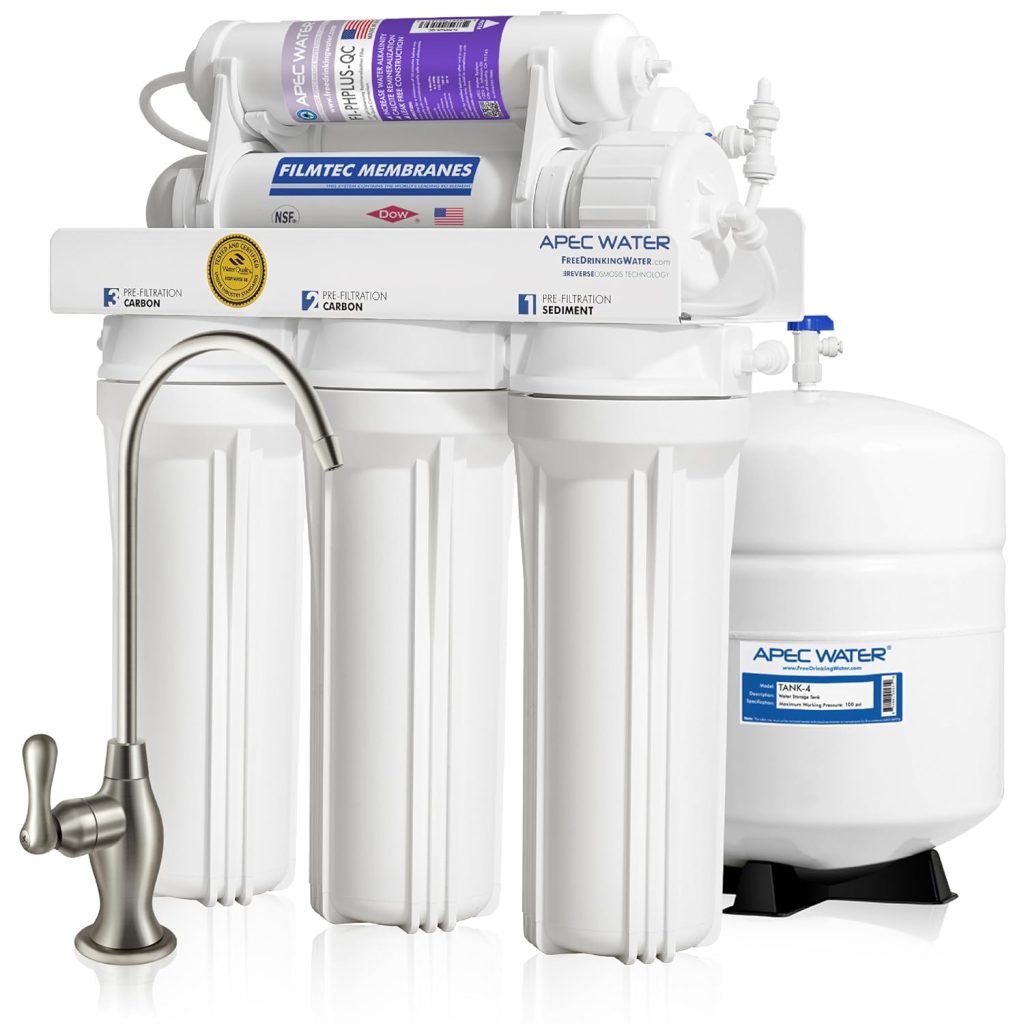
APEC Water Systems provides multi-stage reverse osmosis (RO) filtration. These systems remove heavy metals, chlorine, and other contaminants to make household water safe and good-tasting. The system is designed for under-sink installation.
Best Use Cases
This system works best for households that want high-quality drinking water from their tap. It is ideal for families in urban or suburban areas where water quality is a concern.
Pros
- Improves taste and safety through 6-stage RO filtration.
- Removes up to 99% of lead, arsenic, chlorine, fluoride, and other contaminants.
- Adds calcium carbonate to balance pH and improve taste.
- Built with certified materials for safe, long-term use.
- Low-maintenance design with durable filters that last up to 12 months.
- High output rate supports daily family needs.
Cons
- Only treats water at the sink where installed.
- Wastes some water during RO filtration.
- Installation requires plumbing skills.
1000GPD Under Sink Water Purifier
Price: $297.99
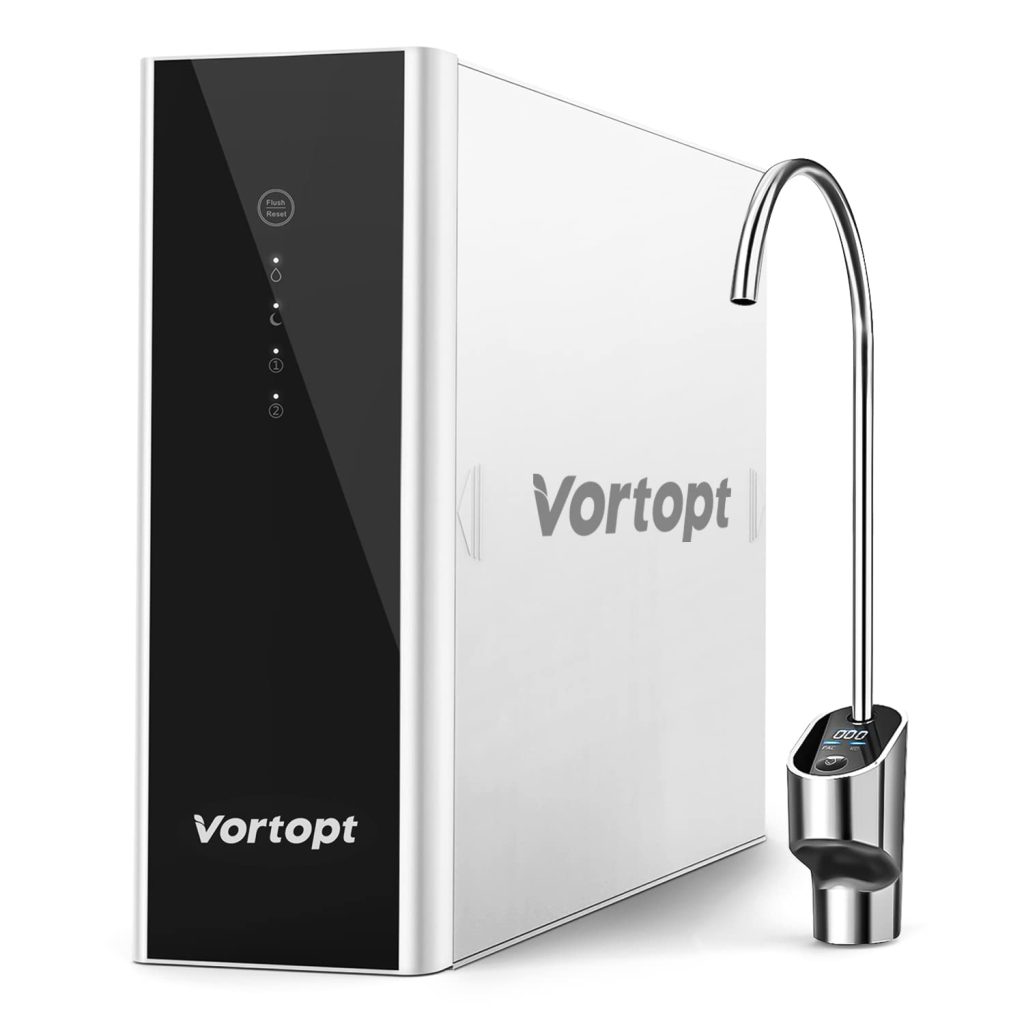
The 1000GPD under-sink purifier uses a high-capacity reverse osmosis system. It has a tankless design that saves space and reduces secondary contamination. Its fast flow rate makes it suitable for large households.
Best Use Cases
This purifier fits households with high daily water needs. It is suitable for families that want steady access to clean water without storage tanks.
Pros
- Provides up to 1000 gallons per day for large families.
- Tankless design prevents bacterial growth inside storage tanks.
- Delivers fast flow, reducing wait times for clean water.
- Saves under-sink space with a compact build.
- The multi-stage process removes heavy metals, chemicals, and sediments.
- Smart system alerts for filter changes.
Cons
- Higher price compared to smaller-capacity units.
- Installation requires steady water pressure.
- Replacement filters add to ongoing costs.
Hardless NG4 Whole House Water Filter – Salt-Free Alternative Softening Device
Price: $349.00
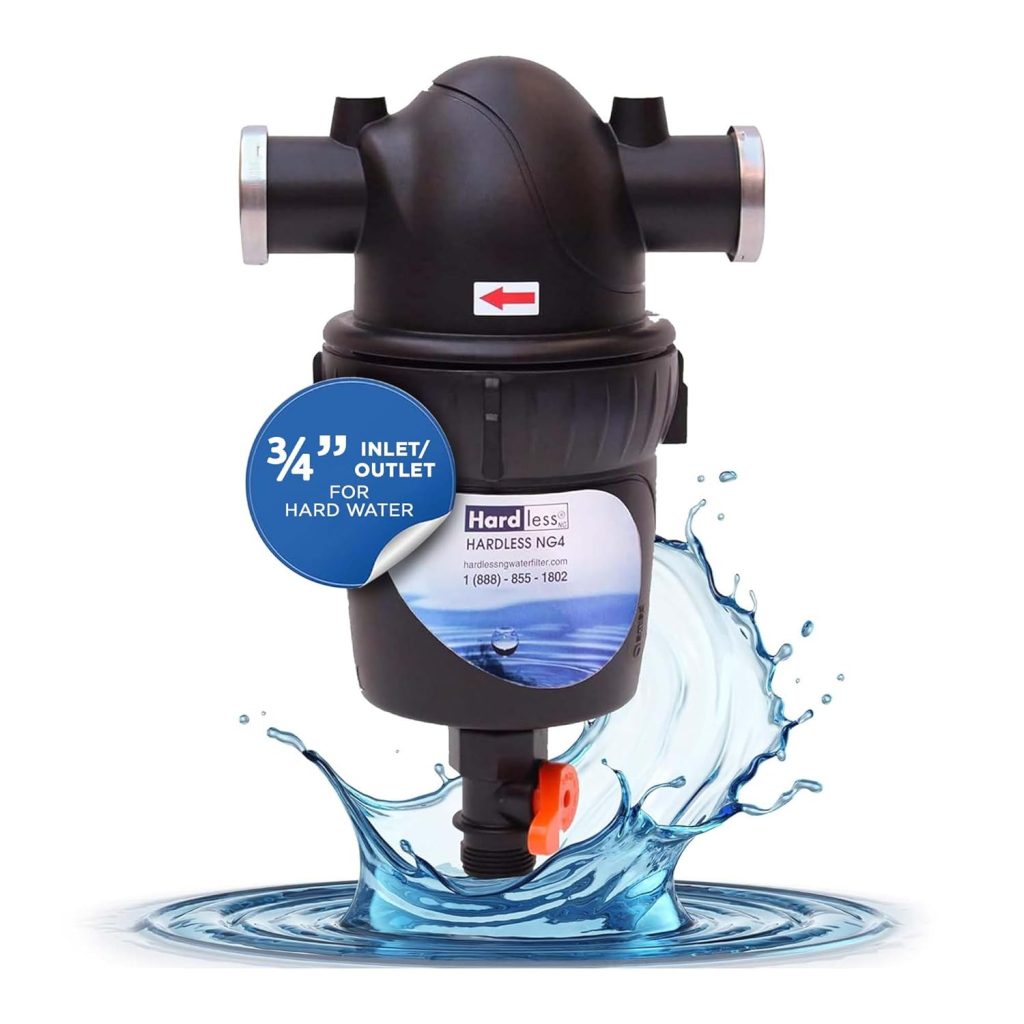
The Hardless NG4 is a salt-free water treatment device for whole-house use. It reduces scale buildup in pipes and appliances without adding sodium. It also filters chlorine, sediments, and odors.
Best Use Cases
This system is suitable for households with hard water that want to protect plumbing and appliances. It is ideal for people who want a salt-free option for healthier water.
Pros
- Prevents scale deposits in pipes and fixtures.
- Salt-free design avoids added sodium in water.
- Filters sediments, rust, chlorine, and bad odors.
- Protects appliances like dishwashers and water heaters.
- Long-lasting cartridge with low maintenance.
- Environmentally friendly compared to salt-based softeners.
Cons
- Does not soften water to the same degree as salt-based systems.
- Best suited for mild to medium hard water, not very high hardness.
- Larger households may need extra capacity.
Waterdrop G2 Reverse Osmosis System, 7 Stage Tankless RO Water Filter System
Price: Ranges from $ 239.99
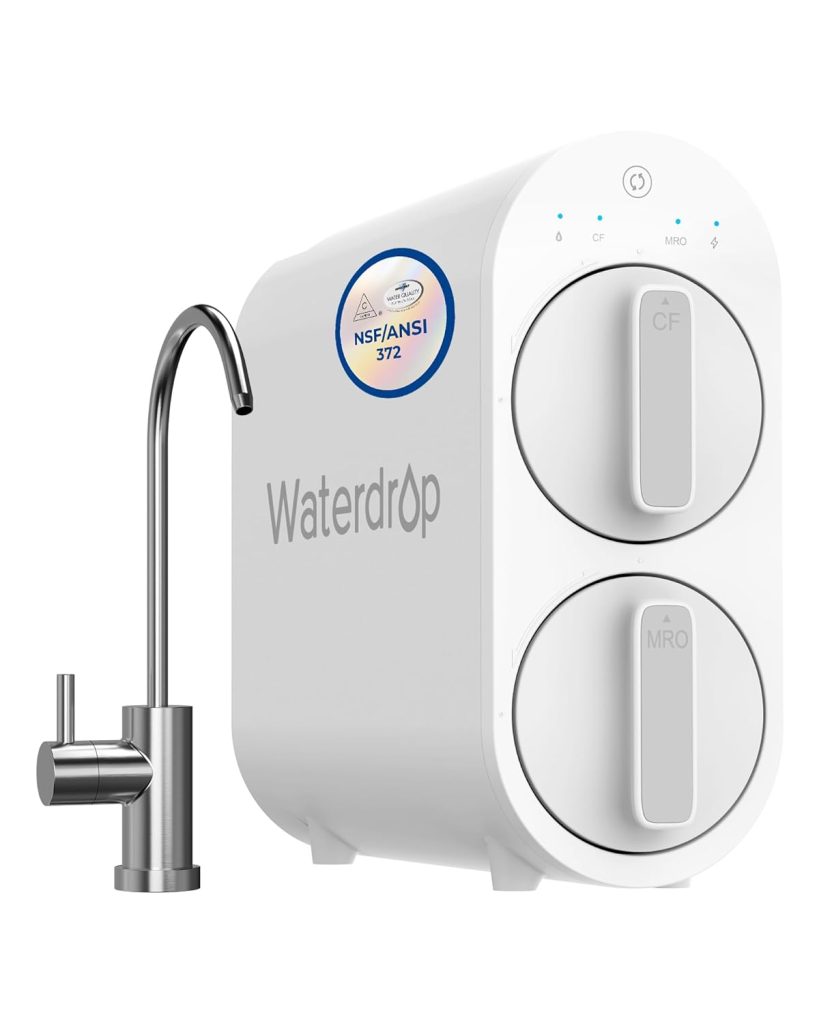
The Waterdrop G2 is a compact 7-stage reverse osmosis system. It uses a tankless design for fresh water and includes multiple filtration layers for advanced purification.
Best Use Cases
This system is best for households that want a space-saving, tankless design combined with advanced filtration. It suits families looking for daily clean drinking water.
Pros
- The 7-stage process removes lead, chlorine, heavy metals, and harmful chemicals.
- Tankless build reduces the risk of secondary contamination.
- Compact design saves space under the sink.
- Provides fresh water instantly with high flow.
- Includes smart indicators for filter replacement.
- Certified materials ensure safe drinking water.
Cons
- Only filters water at one sink, not the whole house.
- Produces wastewater during RO operation.
- Higher filter replacement cost compared to simple filters.
How Do Water Treatment Systems Ensure Cost-Effectiveness?
Water treatment systems ensure cost-effectiveness by reducing energy use, wastewater, and chemical expenses while extending system life. This approach lowers monthly bills for homes and businesses and supports long-term savings with fewer replacements or repairs.
Water treatment systems ensure cost-effectiveness due to these factors:
- Lower energy needs
Efficient systems use advanced membranes and pumps that need less electricity. This lowers power bills for households and cuts operational expenses for large facilities. Energy savings also reduce environmental impact.
- Reduced wastewater generation
Modern reverse osmosis designs recycle more water and waste less during filtration. Families save money on utility bills, while industries face fewer disposal fees. Waste reduction also supports sustainability goals.
- Long filter life
Multi-stage filters and durable cartridges last thousands of gallons before replacement. Fewer changes lower ongoing costs and extend product value. Households gain budget stability, and businesses save on supply orders.
- Minimal chemical inputs
Salt-free conditioners and advanced filtration reduce reliance on softening salts or harsh chemicals. This lowers purchase costs, storage needs, and safety risks. Reduced chemical use also supports eco-friendly water management.
- Lower maintenance costs
Strong build quality and smart self-cleaning functions reduce breakdowns and service visits. Homeowners face fewer repair bills, while industrial users lower downtime costs. Less maintenance extends the total system lifespan.
What Maintenance is Required to Keep a Water Treatment System Effective?
Maintenance is required to keep a water treatment system safe, efficient, and long-lasting. Regular care protects water quality, prevents breakdowns, and ensures the system meets health standards.
The maintenance required to keep a water treatment system effective is:
- Filter replacement
Filters trap dirt, chlorine, and chemicals from the water. Replacing them on time prevents clogging and keeps the water safe. This step also protects later stages in the system.
- Membrane cleaning
Reverse osmosis membranes collect minerals and organic matter. Cleaning removes buildup, restores flow, and protects system efficiency. A clean membrane also extends service life.
- Checking seals and pipes
Seals and pipes prevent leaks and keep pressure steady. Inspecting them avoids water loss, mold growth, and system failure. Secure fittings also ensure compliance with plumbing codes.
- Monitoring pressure and flow
Pressure and flow readings show system health. Sudden drops mean clogging, while spikes mean blockages. Regular checks keep performance stable and prevent costly repairs.
- Regular disinfection of the storage
Storage tanks gather bacteria and biofilm over time. Disinfection with safe agents stops contamination and protects drinking water. Clean storage also keeps the system compliant with hygiene standards.
How Does Investing In A Treatment System Add Long-Term Value To Health?
Investing in a water treatment system adds long-term value by protecting health, lowering disease risk, cutting medical costs, and providing peace of mind. Safe water is the first step to strong family health. It removes germs, chemicals, and metals that harm the body. Drinking and cooking with clean water protects children from stomach infections, diarrhea, and skin rashes. Adults benefit too, as clean water lowers stress on the kidneys and liver.
Clean water also improves taste and encourages daily hydration. Families who drink more water support better digestion, clear skin, and healthy energy levels. Cooking with pure water makes food safer and fresher, reducing harmful residues. Even simple tasks like making tea, washing fruits, or preparing baby formula become healthier when water quality is high. This adds everyday value to meals and routines.
The financial impact is just as important. Clean water reduces hospital visits, medicine costs, and long-term care expenses. Over many years, the savings grow larger than the price of the system. Parents gain peace of mind knowing every glass, meal, and shower supports safety. This trust in water quality brings comfort and confidence for the whole household, building value that lasts for a lifetime.
What signs show my system is failing?
The signs that show that your system is failing are: water flow drops, taste changes, or odors appear. Cloudy water or stains on fixtures also show reduced performance. High total dissolved solids (TDS) readings prove that filters or membranes no longer work. Frequent leaks or pressure loss confirm the unit needs repair. Ignoring these signs risks unsafe water.
Do water treatment systems remove metals?
Yes, water treatment systems remove heavy metals in drinking water, such as lead, mercury, and arsenic from drinking water. Reverse osmosis and activated carbon are most effective. Metals cause health risks, including kidney and nerve damage. Removing them protects families and meets safe water standards.
Is a water treatment system necessary for every household?
Yes, a water treatment system is necessary for every household. Tap water often contains chlorine, sediments, or contaminants. A system ensures safe drinking, cooking, and bathing water. It protects children, seniors, and those with weak immunity. Every home gains health, taste, and long-term savings.
Which step in the water treatment process is most critical for safety?
The most critical step in the water treatment process is disinfection. It removes bacteria, viruses, and parasites. Without this step, harmful microbes survive and spread disease. Chlorination, UV, or ozone systems ensure water safety. Families stay protected when disinfection works properly.
Can modern water treatments remove pharmaceuticals from water?
Yes, modern water treatments remove pharmaceuticals from water. Reverse osmosis and advanced activated carbon filters remove drug residues. Pharmaceuticals like antibiotics or hormones enter water from waste. Long-term exposure harms human health. Removing these contaminants ensures safer drinking water for families.
Is reverse osmosis the best choice for home water purification?
Yes, reverse osmosis is the best choice for home water purification. Reverse osmosis removes up to 99 percent of contaminants, including metals, salts, and chemicals. It improves taste and clarity. RO systems work well for families using tap or well water. They also reduce the risk of chronic disease linked to poor water quality.
Which contaminants are most difficult to remove in water treatment?
The contaminants that are most difficult to remove in water treatment systems are PFAS, also called “forever chemicals”. They resist breakdown and remain in water for decades. Industrial solvents and nitrates are also hard to filter. Specialized systems like RO and ion exchange target these. Without them, exposure builds over time.
Can whole-house water treatment systems replace point-of-use filters?
No, whole-house water treatment systems cannot be replaced by point-of-use filters. Whole-house filters cover all taps but focus on chlorine, sediment, and hardness. Point-of-use filters like RO remove finer contaminants, including metals and drugs. Both types work best together. This ensures safe water for both drinking and household use.
How are industrial water treatment systems different from residential ones?
The industrial water treatment systems are different from residential ones as they use higher-capacity filters, membranes, and pumps. They process thousands of gallons daily for factories, farms, or hospitals. Residential systems treat smaller volumes for kitchens and bathrooms. Industrial setups also meet strict government standards for discharge.
Which modern water treatment system is best in 2025 for home use?
The modern water treatment system that is the best in 2025 is a reverse osmosis unit with multi-stage filtration. It combines sediment, carbon, and RO membranes. This design removes germs, metals, and chemical residues. Tankless RO models also save space and reduce wastewater. Families gain safe, fresh, and affordable drinking water.

